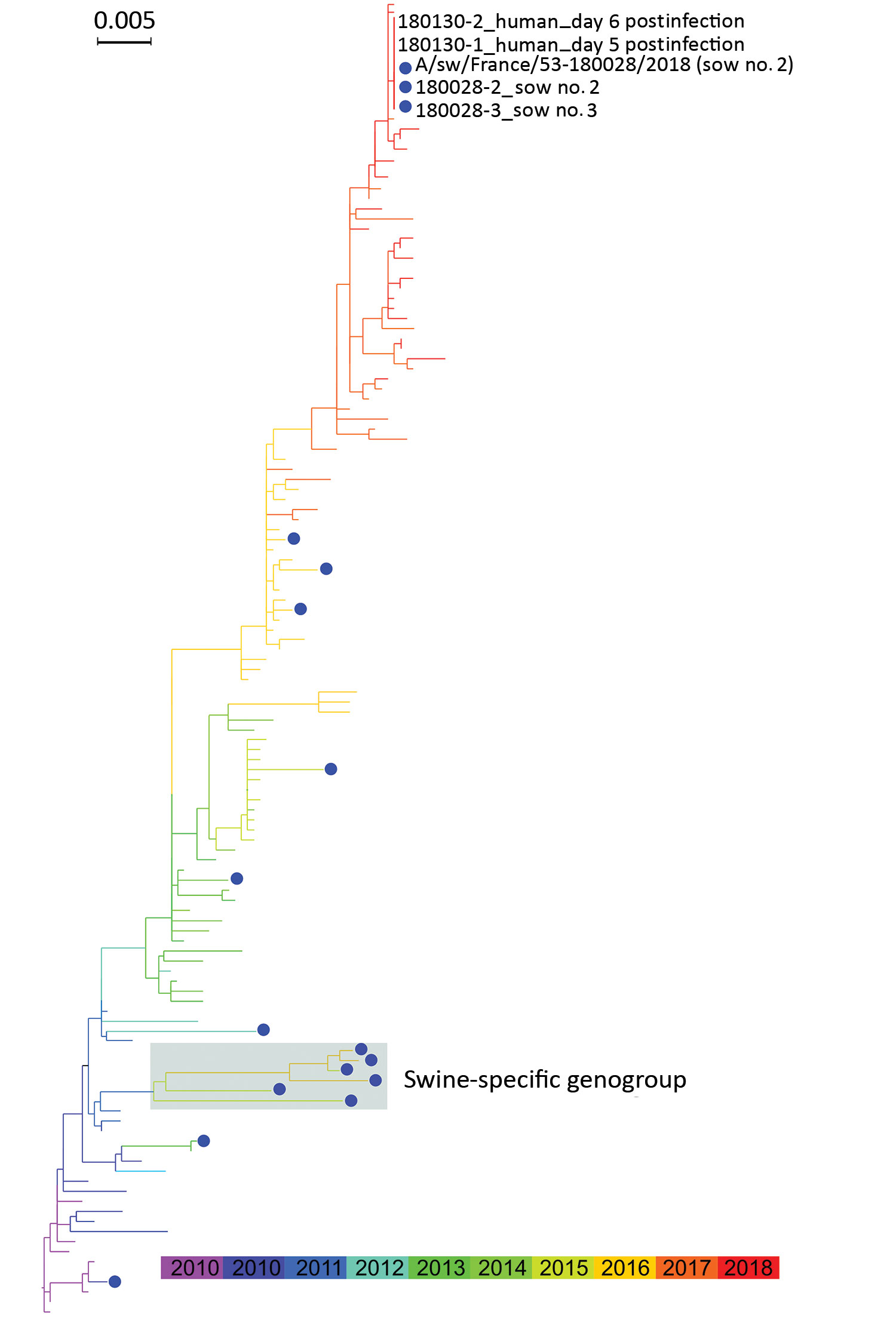Volume 25, Number 10—October 2019
Dispatch
Bidirectional Human–Swine Transmission of Seasonal Influenza A(H1N1)pdm09 Virus in Pig Herd, France, 2018
Figure

Figure. Maximum-likelihood phylogenetic tree of hemagglutinin segments from influenza A(H1N1)pdm09 isolates from swine (blue dots) and humans, France, 2009–2018. Shaded box indicates swine-specific genogroup previously described by Chastagner et al. (6).
References
- Smith GJ, Vijaykrishna D, Bahl J, Lycett SJ, Worobey M, Pybus OG, et al. Origins and evolutionary genomics of the 2009 swine-origin H1N1 influenza A epidemic. Nature. 2009;459:1122–5. DOIPubMedGoogle Scholar
- Adlhoch C, Broberg E, Beauté J, Snacken R, Bancroft E, Zucs P, et al.; European Influenza Surveillance Network (EISN). Influenza season 2013/14 has started in Europe with influenza A(H1)pdm09 virus being the most prevalent subtype. Euro Surveill. 2014;19:20686. DOIPubMedGoogle Scholar
- Simon G, Larsen LE, Dürrwald R, Foni E, Harder T, Van Reeth K, et al.; ESNIP3 consortium. European surveillance network for influenza in pigs: surveillance programs, diagnostic tools and Swine influenza virus subtypes identified in 14 European countries from 2010 to 2013. PLoS One. 2014;9:
e115815 . DOIPubMedGoogle Scholar - Nelson MI, Vincent AL. Reverse zoonosis of influenza to swine: new perspectives on the human-animal interface. Trends Microbiol. 2015;23:142–53. DOIPubMedGoogle Scholar
- Watson SJ, Langat P, Reid SM, Lam TT, Cotten M, Kelly M, et al.; ESNIP3 Consortium. Molecular epidemiology and evolution of influenza viruses circulating within European swine between 2009 and 2013. J Virol. 2015;89:9920–31. DOIPubMedGoogle Scholar
- Chastagner A, Hervé S, Bonin E, Quéguiner S, Hirchaud E, Henritzi D, et al. Spatiotemporal distribution and evolution of the A/H1N1 2009 pandemic influenza virus in pigs in France from 2009 to 2017: identification of a potential swine-specific lineage. J Virol. 2018;92:
e00988-18 . DOIPubMedGoogle Scholar - Garin E, Hervé S, Rose N, Locatelli C, Lecarpentier L, Ngwa-Mbot D, et al. National Network for Surveillance of Type A Influenza Virus in Swine (RÉSAVIP). Review of operations and surveillance results for 2016 [in French]. Bull Epidemiol Sante Anim Aliment. 2017;80:1–5.
- Bonin E, Quéguiner S, Woudstra C, Gorin S, Barbier N, Harder TC, et al. Molecular subtyping of European swine influenza viruses and scaling to high-throughput analysis. Virol J. 2018;15:7. DOIPubMedGoogle Scholar
- Watson SJ, Welkers MR, Depledge DP, Coulter E, Breuer JM, de Jong MD, et al. Viral population analysis and minority-variant detection using short read next-generation sequencing. Philos Trans R Soc Lond B Biol Sci. 2013;368:
20120205 . DOIPubMedGoogle Scholar - Centers for Disease Control and Prevention. Flu can spread between pigs and people. 2018 Jul 5 [cited 2019 Jan 14]. https://www.cdc.gov/flu/pdf/swineflu/transmission-between-pigs-people.pdf
- Fragaszy E, Ishola DA, Brown IH, Enstone J, Nguyen-Van-Tam JS, Simons R, et al.; Flu Watch Group; Combating Swine Influenza (COSI) Consortium. Increased risk of A(H1N1)pdm09 influenza infection in UK pig industry workers compared to a general population cohort. Influenza Other Respir Viruses. 2016;10:291–300. DOIPubMedGoogle Scholar
- Bowman AS, Workman JD, Nolting JM, Nelson SW, Slemons RD. Exploration of risk factors contributing to the presence of influenza A virus in swine at agricultural fairs. Emerg Microbes Infect. 2014;3:
e5 . DOIPubMedGoogle Scholar - Myers KP, Olsen CW, Gray GC. Cases of swine influenza in humans: a review of the literature. Clin Infect Dis. 2007;44:1084–8. DOIPubMedGoogle Scholar
- Kuntz-Simon G, Madec F. Genetic and antigenic evolution of swine influenza viruses in Europe and evaluation of their zoonotic potential. Zoonoses Public Health. 2009;56:310–25. DOIPubMedGoogle Scholar
- Short KR, Richard M, Verhagen JH, van Riel D, Schrauwen EJA, van den Brand JMA, et al. One health, multiple challenges: The inter-species transmission of influenza A virus. One Health. 2015;1:1–13. DOIPubMedGoogle Scholar
1These first authors contributed equally to this article.
Page created: September 17, 2019
Page updated: September 17, 2019
Page reviewed: September 17, 2019
The conclusions, findings, and opinions expressed by authors contributing to this journal do not necessarily reflect the official position of the U.S. Department of Health and Human Services, the Public Health Service, the Centers for Disease Control and Prevention, or the authors' affiliated institutions. Use of trade names is for identification only and does not imply endorsement by any of the groups named above.